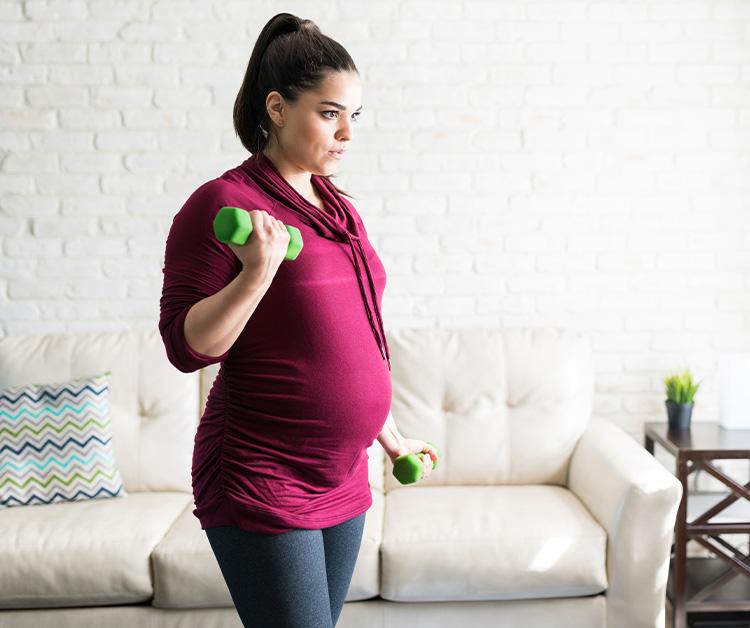Website maintenance scheduled Jan. 9-12; Rebates unavailable Jan. 5-20.

Are common pregnancy myths holding you back from the benefits of exercising while pregnant?
Are Zumba and ab exercises off-limits during pregnancy? Should you ease up in your third trimester? Here’s what you need to know to separate pregnancy fitness fact from fiction.
You may know that exercising while pregnant can bring lots of benefits—ranging from mood support and back pain relief for you to brain development support for your baby. But how do you know which exercises are off-limits or how intense your activity should be? With so much conflicting information out there, it can be tough to navigate pregnancy fitness. Here are some of the most common myths about exercising during pregnancy—and the truths behind them.
Truth: Beginning a pregnancy fitness regimen after you find out you’re expecting is usually fine. Talk with your doctor about your specific situation. The key: Start slow. For instance, you can begin by starting a walking routine and adjusting your intensity as you build up stamina. Prenatal yoga is another gentle option that’s easily adjusted to your fitness level and needs. Let your instructor know that you’re new to the practice. Then start reaping the benefits: A recent study showed that taking just one yoga class lowered a mom-to-be’s anxiety level.
Truth: Unless you’re an avid downhill skier, horseback rider, or basketball player, you most likely don’t need to say good-bye to your activity of choice. Pilates, swimming, and dancing (hey there, Zumba enthusiasts!) are all great choices. Other workouts, like running or lifting weights, can be fine as well. Just talk with your OB or midwife first and make sure you work with your instructor or trainer to introduce modifications as needed.
Truth: While this advice was common in the past, most doctors now take a different approach. When working out, you’re advised to focus on how you feel. You want to work hard but not so hard that you can’t carry on a conversation comfortably. It’s important to listen to your body. Stop exercising immediately and call your doctor if you experience any of these warning signs: headache, dizziness, lightheadedness, chest pain, muscle weakness, calf pain or swelling, more shortness of breath than usual, vaginal bleeding, leaking of fluid, contractions, or a decrease in your baby’s movements. Also, drink plenty of water before, during, and after your workout. You’ll know you’re getting enough if your urine is colorless or light yellow. Dark yellow is a sign of dehydration. And when temperatures outside are high, exercise in the morning or late afternoon when it’s cooler or head indoors to air-conditioning.
Truth: Turns out you can strengthen your abdominal muscles during pregnancy. You likely have to make a few adjustments, however, since traditional ab exercises, like crunches on the floor, can up your risk of injury.
Instead, try pelvic tilts: Get on your hands and knees, with your head level with your back. Pull in your stomach while raising your back. Hold for several seconds, then relax while keeping your stomach muscles taut. Repeat three to five times, building to 10 repetitions.
Leg lifts are another option: Get on your hands and knees, with your arms straight and your hands directly beneath your shoulders. Lift your right knee and straighten your leg behind you so it’s parallel to the floor. Repeat on the left side. Over time, work up to 10 repetitions on each side.
Remember to avoid lying flat on your back after your third month.
Truth: Tune in to your body and pick activities that fit your energy and comfort levels. Experts recommend that women exercise throughout their entire pregnancy—and those last few months are no exception. In the third trimester, you may find it more challenging to keep your balance (thanks to a bigger belly) and breathe deeply (since your baby is pushing up on your lungs), so modify your workouts and take breaks as needed. If you have any of the warning signs that you or your pregnancy could be in danger, stop exercising right away and consult your physician.
All information on Enfamil, including but not limited to information about health, medical conditions, and nutrition, is intended for your general knowledge and is not a substitute for a healthcare professional's medical identification, advice, or management for specific medical conditions. You should seek medical care and consult your doctor or pediatrician for any specific health or nutrition issues. Never disregard professional medical advice or delay seeking medical treatment, care, or help because of information you have read on Enfamil.